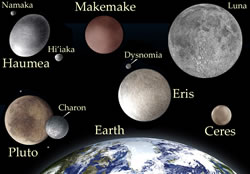Difference between Dwarf Planet and Planet
Key difference: A planet is an object that orbits the Sun in an elliptical orbit, has compounded its matter in a spherical shape and has cleared its orbit of other debris. While a dwarf planet also orbits the Sun, has compounded its matter in a spherical shape, but has not cleared its orbit of other debris.
include("ad4th.php"); ?>
 A planet is a large object that orbits around a star or a stellar remnant. This is mainly due to its own gravity and gravity of the star that allows the planet to have an orbit around the star. The orbit is usually elliptical in shape, mainly depending on the gravitational force of the planet and the star.
A planet is a large object that orbits around a star or a stellar remnant. This is mainly due to its own gravity and gravity of the star that allows the planet to have an orbit around the star. The orbit is usually elliptical in shape, mainly depending on the gravitational force of the planet and the star.
The gravitational force of the planet is strong enough that it leads the planet to be rounded, i.e. compound its matter in a spherical shape. A planet has also cleared its neighboring region of any other debris. The planetesimals, i.e. other debris, should either get absorbed into the planet, or if it big enough to have a gravitational force of its own, it might become a satellite of the planet, i.e. moon, or will just float away into space.
Also see: Difference between asteroids and planets
As per the International Astronomical Union (IAU), “A "planet" is a celestial body that: (a) is in orbit around the Sun, (b) has sufficient mass for its self-gravity to overcome rigid body forces so that it assumes a hydrostatic equilibrium (nearly round) shape, and (c) has cleared the neighbourhood around its orbit.”
include("ad3rd.php"); ?>
Hence, as per this definition, there are currently eight planets in our solar system: Mercury, Venus, Earth, Mars, Jupiter, Saturn, Uranus, and Neptune, in order of distance from the Sun.
On the other hand, IAU defines a dwarf planet as “a celestial body in direct orbit of the Sun that is massive enough for its shape to be controlled by gravitation, but that unlike a planet has not cleared its orbital region of other objects.” The term dwarf planet was adopted by the IAU in 2006 as part of a three-way categorization of bodies orbiting the Sun.
As per the IAU's final Resolution 5A, planets and other bodies, except satellites, in our Solar System can be defined into three distinct categories:
- A planet is a celestial body that (a) is in orbit around the Sun, (b) has sufficient mass for its self-gravity to overcome rigid body forces so that it assumes a hydrostatic equilibrium (nearly round) shape, and (c) has cleared the neighborhood around its orbit.
- A "dwarf planet" is a celestial body that (a) is in orbit around the Sun, (b) has sufficient mass for its self-gravity to overcome rigid body forces so that it assumes a hydrostatic equilibrium (nearly round) shape, (c) has not cleared the neighborhood around its orbit, and (d) is not a satellite.
- All other objects, except satellites, orbiting the Sun shall be referred to collectively as "Small Solar System Bodies."
 The need for this three-way categorization arose as more and more trans-Neptunian objects were discovered. These trans-Neptunian objects, i.e. objects located further than Neptune, were equal to or even bigger than the size of Pluto. Furthermore, it was discovered that Pluto was actually roughly one-twentieth the mass of Mercury, or one-fifth as massive as Earth's Moon. In addition, it was discovered that Pluto has some unusual characteristics such as large orbital eccentricity and a high orbital inclination. Hence, it was completely different than the other planets.
The need for this three-way categorization arose as more and more trans-Neptunian objects were discovered. These trans-Neptunian objects, i.e. objects located further than Neptune, were equal to or even bigger than the size of Pluto. Furthermore, it was discovered that Pluto was actually roughly one-twentieth the mass of Mercury, or one-fifth as massive as Earth's Moon. In addition, it was discovered that Pluto has some unusual characteristics such as large orbital eccentricity and a high orbital inclination. Hence, it was completely different than the other planets.
Also see: Difference between planets and moons
According to the previous categorization, all of the newly discovered trans-Neptunian objects would also be classified as planets, even though, like Pluto, they did not fit the traditional definition of a planet. So, the new three-way categorization model was adopted. Under this model, Pluto was demoted to a dwarf planet, while other solar objects that were too big to be classified as asteroids but did not meet the requirements for a planet were also classified under dwarf planets.
Currently, the IAU recognizes five dwarf planets in our Solar System: Ceres, Pluto, Haumea, Makemake, and Eris. However, only Ceres and Pluto have been observed in enough detail to demonstrate that they fit the definition. Hence, the other may or may not be reclassified as new information is available. It is estimated that there may be 200 dwarf planets in the Kuiper belt of the outer Solar System, and up to 10,000 in the region beyond.
In summary, a planet is an object that orbits the Sun in an elliptical orbit, has compounded its matter in a spherical shape and has cleared its orbit of other debris. While a dwarf planet also orbits the Sun, has compounded its matter in a spherical shape, but has not cleared its orbit of other debris.
Image Courtesy: earthsky.org, factfile.org









Add new comment